How to make biofuel with your own hands from manure at home
Modern technologies for processing all kinds of raw materials open up the prospect of successfully solving the problem of obtaining biofuels from manure directly at home. Moreover, by making biofuel with your own hands at home thanks to new principles of waste processing, you can simultaneously produce fertilizers for agricultural crops.
What is needed for this and how to properly make a bioreactor - we will consider these issues in detail in our article. We will give recommendations on choosing the best raw materials for producing biogas, and analyze the features of using the resulting fuel for household needs.
Of course, the easiest way is to purchase ready-made industrial plants. However, their high cost forces us to consider options for making production systems ourselves.
The content of the article:
Briefly about the definition of biogas
According to scientific definitions, biogas is a product obtained as a result of the fermentation process of a mass of biological waste. In this case, the fermentation product is methane or hydrogen.
The formation of methane (or hydrogen) occurs as a result of the vital activity of three types of bacteria:
- hydrolytic;
- acid-forming;
- forming methane.
A high-quality fermentation product is considered to be the composition of a gas mixture, the contents of which are distributed in the ratio: 50-85% methane, 15-50% carbon dioxide, and less than 5% hydrogen sulfide.
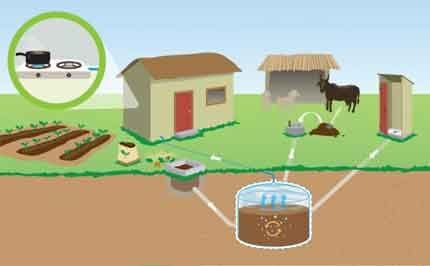
This gas mixture is passed through filters to remove the presence of CO2 and H2S, after which pure biological methane remains. Such gas is no different from natural gas used in domestic and industrial applications.
The raw materials for obtaining a high-quality biological gas mixture are usually:
- manure and bird droppings;
- alcohol production waste (stillage);
- surplus brewing production (beer grains);
- fecal matter and fish waste;
- beet pulp, household waste, grass, etc.
This is only a part of all raw materials allowed for use. But even this list shows how diverse the list of raw materials is to be able to establish biogas production on an ongoing basis.
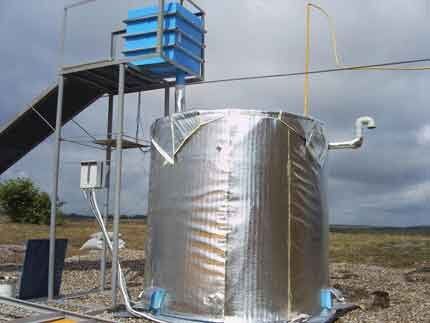
The volumetric yield of the gas mixture directly depends on the type of raw materials used and the content of dry substances in it. So, if you use cattle manure in business, you can actually get 50-60 m from one ton of manure3 biofuels, containing up to 60% methane.
It is believed that the best raw materials are waste with a high fat content. Processing one ton of fat waste through a classic biofuel production plant can produce up to 1300 m33 gas mixture, where the methane content reaches 90%.
How to make a processing farming module?
In order to make a system for processing waste into biofuel, at a minimum, you need to be aware of the operating principle of such devices, as well as have an understanding of circuitry.
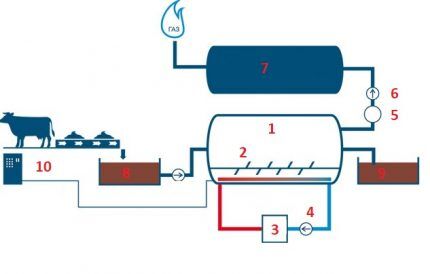
Let's consider both, but it should be noted: the construction of a full-fledged installation is quite troublesome and costly. At home, as a rule, you can only make something similar to recycling stations. However, some attempts are successful.
The principle of operation of the bioinstallation
Biofuel production technology generally supports the following systems approach:
- The bioreactor (container) is loaded with manure.
- For a certain time, a fermentation process takes place inside the reactor.
- A gaseous environment is formed.
- Gases are being removed from the reactor.
- The gas mixture is purified and sent for use as fuel.
The composition of the resulting gas mixture is characterized by a fairly high saturation of various substances. The largest percentage component is methane (60%), carbon dioxide (35%) and other substances, including hydrogen sulfide (5%).

Meanwhile, for the effective operation of a gas-forming station of home production, significant reserves of waste from representatives of the animal world are required.
Therefore, the first thing you should pay attention to in solving the problem of obtaining biofuel at home (country) is the availability of sources of raw materials for the processing plant.
Making a bioreactor with your own hands
Having decided on the sources of raw materials, you next need to decide on the location of the home (or country) bioreactor. The reactor itself is a sealed vessel, quite durable, with a volume based on the daily intake of manure raw materials for processing (for reference: to obtain 100 m3 gas mixture requires approximately 1 ton of manure).
Table of the relationship between the type of manure and the amount of biogas produced

Such a container will have to be installed on a strong foundation, equipped with shut-off valves and other technical paraphernalia according to the classical scheme. It is advisable to make the upper part of the vessel removable, with bolt fastenings and a sealing gasket.
To ensure cycle continuity, the storage tank must be equipped with an artificial heating module. If in summer the efficiency of manure fermentation and the rate of gas formation are fully ensured by external temperature conditions, in winter the situation changes.
For winter operation of the bioreactor, artificial heating is required, given the cessation of the activity of fermentation bacteria already at 4-10 ° C above zero. Accordingly, the container must have high-quality thermal insulation. The classic method of insulating with mineral wool is suitable for this.

There are several options for organizing heating. For example, the use of electric heaters or a water heating system (water jacket).
The power of the heating circuit should be calculated based on the optimal temperature inside the reactor of 25-40 ° C, necessary to achieve an effective biomass fermentation process.
In addition to heaters, the fermentation activity of biomass is influenced by the degree of its stagnation. Essentially, inside the tank, the manure material must be constantly in motion. The movement of biomass enhances the fermentation process and reduces the time for obtaining the gas component.
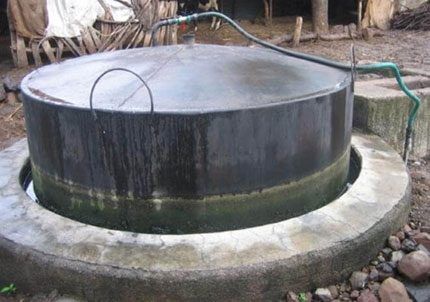
The problem of organizing motion is solved by introducing a special mechanical stirrer into the design of the bioreactor. The shaft of this device is connected to the shaft of a low-speed motor, which carries out the rotation action. Turning the mixing process on and off can be done manually or automatically.
We have another article on our website that provides installation instructions to obtain biogas for the needs of a private home.
Biogas and fertilizer production process
The design of the system for producing biofuel at home technologically involves loading the vessel with manure to approximately 1/3 of the capacity. To load manure, a loading hatch with a hermetically sealed door is made. The remaining free upper area of the bioreactor is used for the accumulation of released gases.
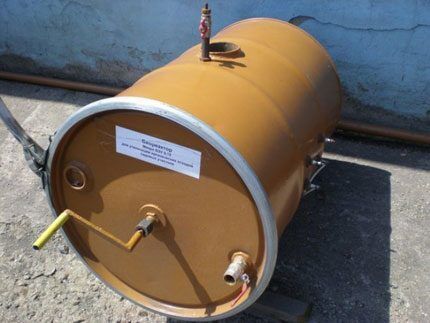
Exit holes must be made at the upper and lower levels of the vessel. At the top there is a gas outlet, at the bottom there is an outlet for draining treated manure (fertilizers). It is also advisable to mount an observation window in the area of the upper area of the vessel to monitor the process.
The pipe for discharging the gas mixture is connected by a sealed pipe to a device that simultaneously performs the functions of a separator and a water seal. For communication, a pipe (metal or polyethylene) of small diameter (25-32 mm) is used.
The separator itself is a vessel of relatively small capacity filled with water. The gas passing through the water column is purified and discharged into gas holder and then served to consumers.
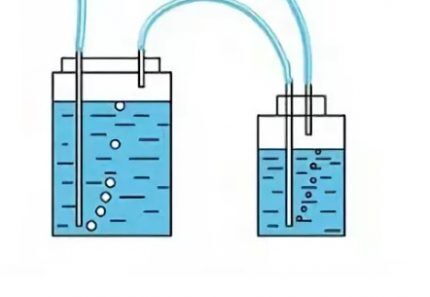
It is advisable to make the lower pipe on the reactor (for the outlet of waste manure - sludge) as large in diameter as possible. A shut-off valve (valve) is connected to it and a drain is made to a tank for collecting sludge. The spent mass on the farm can be successfully used as fertilizer.
We reviewed detailed information on determining the required volume of the container, as well as on calculating the efficiency of the bioreactor and the feasibility of using biogas in next article.
What should the composition of the manure mass be?
The mass of manure loaded into the bioreactor should not be considered simply as a raw material suitable in any quality. The component of the substance is of fundamental importance for the fermentation process. In practice, it has been noted that a reduction in substrate particles is accompanied by better process efficiency.
Pronounced fibrousness of the substrate and an increase in the area of interaction of bacteria are the main criteria that contribute to the rapid decomposition of the manure mass. In this state, the manure raw material, when heated and mixed, does not form sediment or film on the surface, which greatly simplifies the filtration of the gas mixture.

The degree of grinding of the raw material determines the duration of fermentation, which in turn affects the volume of gas produced. Thus, to reduce the fermentation time, it is necessary to grind the raw materials well: the better the grinding quality, the shorter the fermentation period.
Features of the use of biogas for household needs
The scope of application of this type of energy resource is quite extensive. By using biogas as fuel, electricity is produced, hot water or steam is produced. There are numerous examples from practice where biofuel is used to fuel vehicles.
But in order to avoid problems on the farm when using such fuel, it is extremely important to arrange a storage facility for the resulting biogas, allocating the right place for the gas tank Location on.
Biogas plants of this type are equipment that opens up the possibility of creating waste-free production. In this regard, individual countries of Western Europe provide a good example.
For example, in Denmark, the production of this type of fuel has reached almost 20% of the country’s total energy resources. In large regions of the world - India and China - the number of biogas plants runs into the hundreds of thousands.
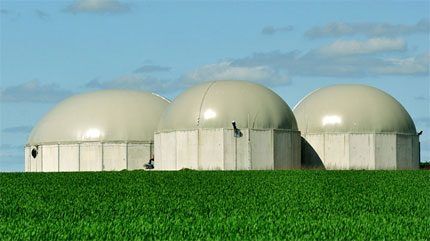
It is not for nothing that there has been a significant increase in interest around the world in biogas production processes.
This is one of those energy options that is classified as an alternative source and for which they see the future, so farmers and housing and communal services managers, owners of private farms and small businesses are closely monitoring the development of technology.
Conclusions and useful video on the topic
Review of a unit for the production of biogas, in the manufacture of which a 127 liter plastic tank is used. Features of the device and operating tips.
Of particular interest in the use of installations is manifested among owners of the restaurant and gastronomic sphere, where the topic of processing food waste remains relevant. On this basis there is a good opportunity to create cheap recycling of organic waste for the benefit of farms. Finally, biofuel production technology means real conservation of the environment, which cannot be said about the production of other energy drinks.
Are you interested in the production of biofuels and want to clarify some points? Ask controversial questions in the comments - our experts will try to clarify such points.
Or maybe you are familiar with the manufacture of a bioreactor and the process of producing biogas firsthand? Share your practical knowledge and your opinion on this issue under our article - many business executives will be interested in your experience and recommendations.




I agree that this is very expensive and labor-intensive. However, I once saw a program on Discovery that talked about the success of such devices on farms in Sweden. But so far, in my opinion, in Russia it is troublesome and not very profitable. Because the price of energy is quite low, and the effectiveness of such devices in relation to costs is questionable. I think that for now this would be suitable for home farmers in hard-to-reach regions (in particular, in swampy areas), where there is no gas pipeline, electricity, etc., and then raw materials need to be somehow provided. But the idea is worthwhile.
Not very beneficial for small garden plots with small volumes of manure.For large complexes with hundreds of tons, this may make sense, but they see no reason to do anything if everything is already working.
If the gas is odorless, how can you determine the leak?
Biofuel as an alternative to natural gas has long been used in a number of countries on an industrial scale. We are making timid attempts to develop the production and operation of bioenergy plants. Our folk craftsmen, as always, ahead of heavy (on the rise) industry, are already riveting them with might and main.
The productivity of homemade installations is low, but they are just right for farmers. On a farm, the resulting gas, for example, will be used for heating in winter, heating water, and preparing feed. And a shower for people is a milkmaid’s dream.
In my opinion it is beneficial. It is possible not only manure but leaves, grass, hay, weeds, kitchen waste and human waste, instead of cesspools in the BSU and the output is fertilizer and gas. If a biogas unit is installed in the greenhouse, then carbon dioxide will also come in handy. Also, why build unprofitable wind turbines and solar panels and batteries for them... When you buy a generator, you will have electricity and gas as a by-product and good fertilizer. It is more profitable than running pipelines to small villages.
Interestingly, no one has tried to use hogweed as a raw material, instead of corn silage...
To help create these installations, the TERMOMONOLIT building system can be used, and a THERMOGENERATING ROOF made from TERMOMONOLIT panels can serve as heating for the reactor, water and heating of any size house. Gas must be used for its intended purpose: stoves, car refueling and electricity.In this arrangement, gas will be produced a little more than normal and the temperature in the reactor can be adjusted automatically all year round.